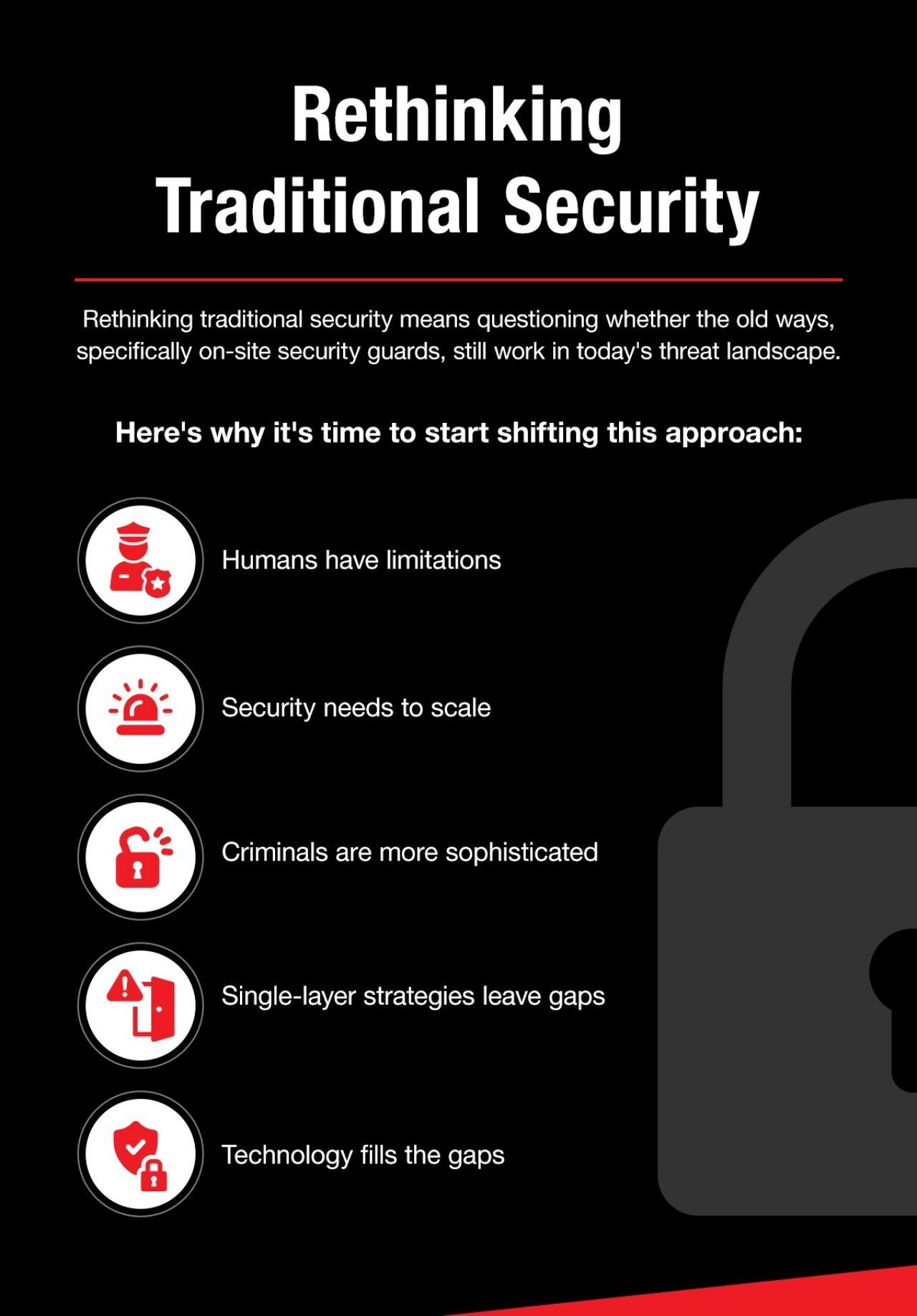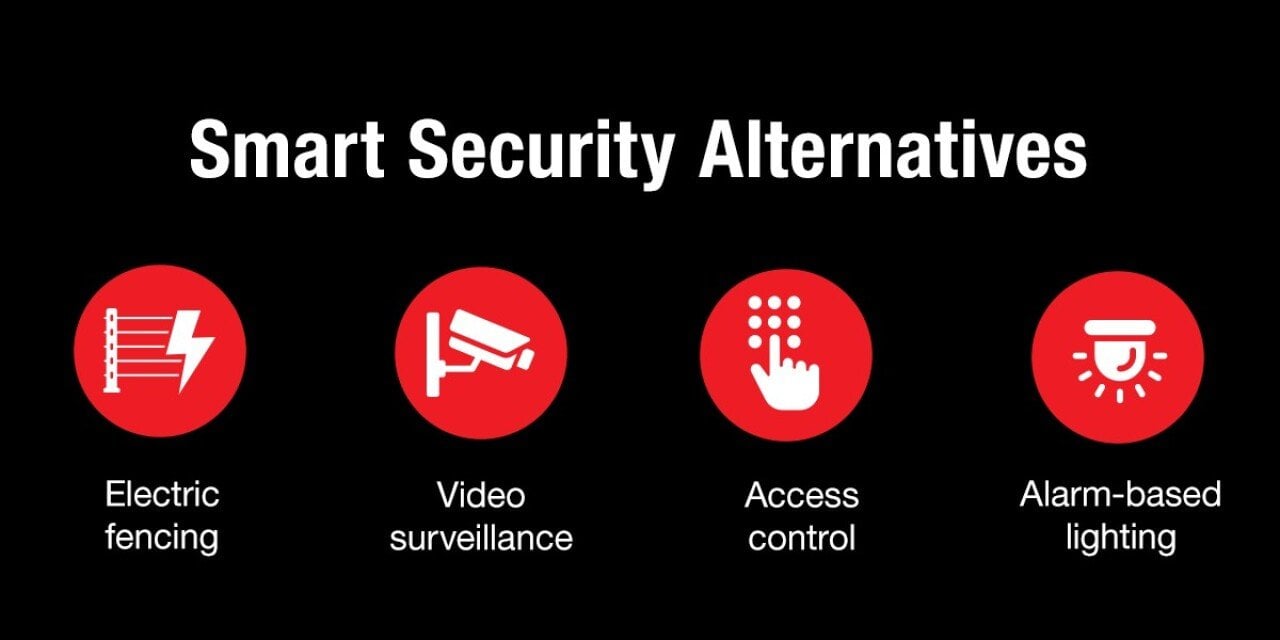Traditional security guards have long been used to deter threats, monitor access, and provide a physical presence on-site. For many businesses, especially those in logistics, construction, and trucking industries, guards have offered a sense of control and visibility. But today, the security guard model is under pressure. Rising labor costs, staffing shortages, and inconsistent performance are forcing businesses to rethink their strategy for protecting their profits, people, and property.
Is hiring security guards worth it? While they can help deter threats, relying solely on security guards exposes your business to gaps. Guards can miss blind spots, become fatigued, or face limitations during emergencies. Inconsistent coverage, especially at night or in remote areas, leaves assets vulnerable. These challenges don’t mean that guards offer no value, but they do highlight the need for a smarter, more comprehensive approach. Amarok shares multi-layered security strategies that fill the gaps and strengthen your overall defense.

Do on-site security guards still work in today’s threat landscape? Many businesses still invest in guards, static fencing, or traditional locks — but these tools and strategies weren’t built for modern-day risks. Here’s why it’s time to start shifting this approach:
Security guards are often the go-to solution for protecting assets and property. But for today’s businesses, simply hiring guards without implementing any other measures comes with more risk than many realize.
From rising costs to limited coverage, there are five main drawbacks of hiring security guards that every business should weigh carefully. Understanding these challenges is the first step toward building a stronger, more reliable security strategy.
Training new guards is a recurring cost. The security industry’s high turnover means businesses often train guards who don’t stay long enough to deliver consistent value. Reports indicate that the annual security guard turnover rate can range anywhere from 100% to 400%. This means companies frequently retrain new staff to maintain baseline coverage. Onboarding and training each new guard requires a significant amount of time and money.
When new hires leave within months, businesses lose out on that investment and expose themselves to additional risk. Turnover directly affects:
Guards need to learn the unique challenges for each property — where blind spots are, how access gates work, and what suspicious activity looks like for that specific operation. This knowledge disappears when a guard leaves. The more the process has to be repeated, the more costs are driven up with every turnover. Skipping training isn’t an option, as poorly trained guards are more likely to make mistakes, mishandle incidents, or miss critical warning signs. The result can be legal exposure, asset loss, and reputation damage, all of which cost much more than the training itself.
Security guards face physical limits, especially when tasked with covering larger properties, lengthy perimeters, or remote locations. One guard can only be in one place at a time. Even a team of guards can’t watch every blind spot, access point, or area along a site’s perimeter. This limitation leads to serious vulnerabilities for sprawling locations like construction zones and distribution centers.
Extensive perimeter lines are difficult to consistently patrol, especially on foot. Remote locations often lack nearby backup or law enforcement presence, so guards must rely on limited resources during an incident. In rural or industrial areas, slow response times can turn a minor breach into a major loss.
Other physical limitations include:
Coverage gaps create real risks. When guards are tied up responding to an incident, other areas go unwatched. Thieves know how to exploit this, studying security guards’ habits and patterns and waiting for the right time to act.
Managing large or spread-out sites with guards alone often means reacting to incidents after the fact instead of preventing them proactively. Without a multi-layered physical security strategy, the risk of trespassing, theft, vandalism, and loss is high.
Contracted security guards are often overtasked and have too few resources. Whether they’re covering multiple properties, managing access control, or watching video surveillance feeds, they’re expected to multitask under pressure. Divided attention leads to slower responses, weaker deterrence, and more security gaps.
Multitasking weakens performance. A single guard monitoring cameras, signing in visitors, and patrolling the lot can’t give their full attention to any one task. If they’re handling paperwork at the front desk, they may miss a suspicious vehicle on a feed. If they’re on patrol, they won’t be able to respond to unauthorized access at a side entrance quickly. This divided focus impacts these critical areas:
Many security firms reduce costs by stretching their personnel across several sites. One guard may cover three buildings in one shift or rotate between sites miles apart, leaving gaps where no one is watching. In this sense, technology solves what humans can’t do. Technology doesn’t get distracted, tired, or overworked. Surveillance cameras can cover various areas, and remote monitoring ensures that every entry point is always under watch.
Between rising wages, overtime, training, insurance, and inconsistent performance, the total cost of guard-based security quickly adds up and doesn’t always deliver the coverage or deterrence that businesses need. According to data from 2024, a security guard’s annual salary is between $37,000 and $53,000, not including overtime or emergency call-ins. And in the case of overtime, the pay must be at least 1.5 times the amount of the guard’s hourly pay rate.
Other factors that affect security guard costs include:
Relying solely on guards locks a business into a labor-based security model that gets more expensive over time. Technology-enabled solutions like electric fencing offer consistent, 24/7 protection without the unpredictability of human staffing.
Remote locations are often isolated, poorly lit, and far away from police patrol routes. Guards assigned to these areas face higher risks and limited backup since emergency response times are slower, leaving sites more vulnerable to trespassing. Remote facilities put more pressure on security guards, especially in cases where there aren’t enough guards on duty, for the following reasons:
Businesses operating in remote zones, such as substations, laydown yards, or facilities in more rural locations, face real and recurring challenges. A multi-layered strategy is essential to bridge the gaps and provide reliable protection where guards alone fall short.

Security guards can become easily overextended, and when that happens, security breaks down. These challenges are prompting a shift toward smarter, technology-enabled, multi-layered security strategies that offer wider coverage, real-time alerts, and stronger incident response.
A unified approach to perimeter security delivers consistent performance at a fraction of the long-term costs of staffing traditional guards. Technology doesn’t get spread too thin or need to take breaks — instead, it helps prevent external theft proactively.
Each security layer addresses specific limitations of guards while increasing crime deterrence and response times:
Threats evolve, and so should your security strategy. Relying on outdated, manual systems or a single line of defense, like security guards, exposes your business. Future-proofing means taking a more flexible and scalable approach. More businesses are adopting multi-layered security, leaning into proactive instead of reactive threat management.
Static solutions like traditional fencing or security guards alone often fall short as threats become more organized. Criminals today use tools like signal jammers and even social engineering to bypass outdated systems. Future-proofing starts at the perimeter, which is your first line of defense. A smarter approach to physical security integrates various types of technology, ensuring 24/7 protection without the need to hire and train guards.
Operational and financial sustainability are other important factors. A security guard program may not scale well, especially for businesses with large or multiple sites. Labor costs rise, and coverage gaps grow as hiring becomes more difficult.
Perimeter security solutions help solve that challenge by offering consistent, around-the-clock coverage without the risk of burnout or turnover that comes with security guards. Electric fencing, video surveillance, access control, and lighting all work together, and their coordination strengthens your overall security posture for greater visibility and protection.
Ultimately, future-proofing your business security is about building resilience. It’s about being ready for the security challenges that tomorrow brings.
This story was produced by Amarok and reviewed and distributed by Stacker.
Reader Comments(0)